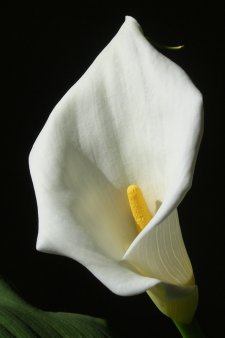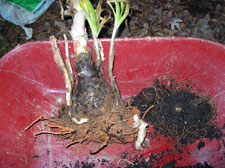
My houseplants love their outdoor summer vacation. The bright light, fresh air, and quenching rains do wonders for their health. They grow more robust and get charged up for the rest of the year. Most of our houseplants are from tropical or desert areas where cold weather is rare, and they thrive in summer conditions that are similar to home. But sooner or later the fall nights get nippy. Since temperatures below 50 degrees can stress some tropicals, it's time to curtail the vacation and bring them indoors.
Many gardeners help their houseplants slowly readjust to indoor conditions by bringing them in at night and moving them back outside during the day -- similar to hardening them off in spring. A week of this routine helps plants prepare for the changes in humidity, air circulation, and temperature. I admire those dedicated gardeners for doing things the right way, but I have too many plants and too little time for that. Usually I just pick a sunny day in early October and bring in the whole lot. At this time of year there is very little temperature difference between outdoors and indoors because my windows are usually wide open (a point of contention with my wife, especially on 55-degree nights).
The first step to bringing in houseplants is cleaning them. I remove damaged leaves and spent flowers. Then I closely inspect every leaf and pot for spiders, ants, ladybugs, pill bugs, centipedes, and the like. I always find some. Some of these insects will escape notice at first, and that's okay. When they make their appearance indoors, gently carry them outside.
Houseplants that are active in the wintertime, such as Christmas cactus, calla lily, pregnant onion, and dracaena, can be submerged in a large bucket. After a minute or so, all the creepy crawlies will float to the top and can be skimmed off. This not only gets rid of the bugs, it also cleans the pot and waters the plant. Plants too large for soaking can be placed in the shower.
Plants that are dormant or semi-dormant in winter should not be watered or soaked before the move indoors. These include aloe, agave, blood lily (Scadoxus haemanthus), string-of-pearls, and most other succulent or bulbous plants. They are accustomed to a dry period of a few months. Clean the insects out of them by hand or with a dry cloth.
Far worse than the harmless hitchhikers are the ravenous plant pests. Outdoors, spider mites, whiteflies, thrips, and aphids are kept in check by predators and environmental conditions. Indoors, these pests can rapidly get out of control. That's why inspection and cleaning are crucial. The pests are so tiny that soakings and showers don't displace them. Use an old rag to wipe upper and lower surfaces of each leaf. And remember to check the leaf axils.
Despite these precautions, every winter our calla lily and sweet potato vine attract spider mites. Perhaps there is a bank of eggs in the soil or some gremlin that comes through every New Year's Day and sprinkles spider mite dust. I don't know, but they love those plants! So winter maintenance for pest-prone plants includes close monitoring and washing the leaves over the sink -- especially the undersides -- every couple of weeks. This keeps the numbers in check. Prevention is the easiest way to stop a serious infestation.
Once cleaned, the plants are ready to be brought indoors. Bright-light plants get south and west windowsills. I group lower-light plants on stands or tables near windows. In winter most houseplants need less water and fertilizer. But if your house is particularly dry, plants that like humidity, such as African violets, moth orchids (Phalaenopsis spp.) and jewel orchids (Ludisia discolor), benefit from sitting on a humidity tray. This is simply a shallow tray filled with pea stones and water. As the water evaporates, it raises the humidity around the plants.
Treating my houseplants to summer outdoors seems to remind them of the potential locked away in their genes. They grow sturdier and produce more flowers. Our house is ablaze in winter with the gorgeous, intricate blooms of moth orchids, corn plants, Amazon lilies (Eucharis spp.) and calla lilies. Houseplants enrich our lives with color and vitality, not to mention oxygen -- all of which is especially important to those of us living in sterile environments of concrete and steel. They work wonders in lifting the winter doldrums. If we keep them happy, they'll keep us happy!

Some tender perennials, especially summer-blooming bulbs, require a dry, dormant period during winter. Lift elephant ears, begonias, amaryllis, crinums, and pineapple lilies before a hard frost and allow the bulbs (some are technically corms or tubers) to dry in a cool, shaded area. Clean debris and spent leaves from the bulbs, and place them in a box or bag in dry peat moss, mulch, or sand.
Dahlias, gladiolas, and cannas can stay out until after a hard frost. Once the leaves and stems have turned black or mushy, trim any stems to a few inches above the bulbs, carefully lift the bulbs, and let them dry in a cool, shady spot.
Once dry, place the bulbs in dry peat, mulch, or sand, and store them in a cool, dry, dark location where temperatures will remain above freezing -- ideally at 40 to 45 degrees. Once a month, check the bulbs to make sure they are not diseased, wet, or shriveled. They should feel dry and firm, like a good sweet potato or onion. Discard any diseased or rotten bulbs. And don't worry if you lose a few; that's a great excuse to buy more next spring.